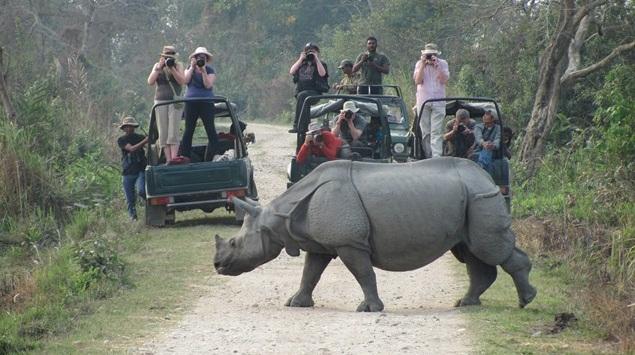The Great One Horned Rhinoceros is one of the rare and precious wildlife in the world and a state symbol of Assam. The poaching of this heritage species in the recent years in record numbers in its natural habitats, especially in Kaziranga, not only brought the animal to the edge but also created confusion among the public on the efficacy of the protection measures adopted by the forest department.
A World Heritage Site and an ideal habitat for the breeding of rhinos, Kaziranga has seen a rise in the number of the species. The animal shrugged off its ‘endangered’ tag as soon as its population crossed the 2000 mark. This fuelled a overweening strategy--the much hyped Indian Rhino Vision -- that targetted 3,000 rhinos by the year 2020 in the rhino-bearing sanctuaries of Assam. However, with the number of this pre-historic pachyderm crossing the 2,500 mark, a host of challenges also came to the fore, poaching being only one of the concerns. Kaziranga--the one of its kind of habitat in the world has been plagued by other challenges like-- shrinking of the habitat, encroachment of the corridors around the Park, siltation of the waterbodies and a complete lack of protection of the watershed of Kaziranga. Another potential threat for the rhino comes from the confinement of the other two big mammals within the Park--the Asiatic elephant and the Asiatic buffalo. The conservation of rhinos in Kaziranga started almost 110 years ago but conservation seems more in a jeopardy now than it was hundred years back! With the the growth of wild life population as well as the ever swelling human habitations in and around the Park, it has become a daunting task to meet these challenges without proper advisory and practice.
Instead of dealing with the long-term conservation challenges and preservation of this unique site, the Indian Rhino Vision only went on pulling out rhinos from Kaziranga and Pobitora for translocation solely keeping in view the magic figure of 3,000 rhinos by 2020. Manas National Park, another World Heritage Site and Laokhowa and Burhachapori Wildlife Sanctuaries remained preferred destinations for the translocation of rhinos under the IRV 2020 initiative. However, translocation to these wildlife areas remains a daunting task as these sanctuaries continue to be vulnerable. Rhinos were falling prey to poachers and the slaughter and maiming of the species continued unabated. Poaching of the rhino, even of the translocated animals, overshadowed the whole IRV process.
IRV's translocation process has come under the scanner as half of the translocated rhinos to Manas got killed by the poachers. Without adequate patrolling staff, it is a colssal task for a few people to constantly guard the animals against human rapacity. There were allegations that the IRV stakeholders simply washed off their hands once the translocation process was over; they were never bothered about the safety of the translocated animals. This was indeed a grave allegation. The killing of translocated rhinos not only contradicts the conservation efforts but was also a huge setback for the IRV 2020 programme. The killing of seven translocated rhinos since 2011 in Manas World Heritage Site triggered the World Heritage Committee to send an alarm to the state that further deterioration of protection in Manas and subsequent damage caused to key attributes in Manas may lead to de-listing Manas from the World Heritage Site list.
Even after the debacle at Manas, the IRV stakeholders did not seem to learn the basics: to tighten up the protective mechanism in the sanctuaries that are soft targets for the poachers. Instead, they agreed upon on a temporary band-aid effort of "trimming" horns on translocated and stray rhinos in Assam. The decision, taken at the IRV 2020 partners meeting on January 30, 2014 at the Assam State Zoo was met with strong opposition from conservationists and the state forest department was compelled to form a committee to ascertain feasibility and necessity of the dehorning process. While the method of dehorning was followed in a few parks in Africa, this doesn't seem to deter the poachers. The rhinos endure a certain amount of stress in the dehorning exercise and once their horn has been removed, they no longer have that defence mechanism. In the case of female rhinos, when they give birth to a calf, they need the horn to help the newborn rhino to its feet. The other disadvantage of dehorning is that the horn grows back and the dehorning process has to be repeated on a regular basis throughout the rhino's lifetime. Noted conservationist Dr Dame Daphne Sheldrick came out to voice strongly against the proposal--" In my opinion, this would be disastrous. If evolution has not removed the horn from rhinos over the millenia, it surely means that the horns are essential to their existence and survival. Dehorning a rhino is emasculating it, depriving it of its means of defense and part of their anatomy upon which they devote an enormous amount of time , shaping, sharpening, etc. It's their identity. Removing it will dent their confidence to such an extent that a dehorned bull rhino will never be confident and fertile to breed. A Rhino deprived of its horn is no longer a Rhino".
Belinda Wright, a leading crusader against wildlife crimes and executive director of the Wildlife Protection Society of India came out equally vociferous -- "Apart from the risks involved to the animal, this is not an effective way to curb poaching, whereas intelligence-led enforcement is. If excellent protection measures are put into place and sustained, including intelligence-led enforcement and a network of informers, this will be the best long-term investment that Assam could make to preserve it's magnificent natural heritage."
As the coordinator of the Assam Environmental NGO Forum, this writer too, was also included as a member of the Committee to ascertain the feasibility and necessity for proposed de-horning of translocated rhinos. The Forum, that voiced its concern and opposed the dehorning proposal from the beginning took a tough stand on the issue and tabled its opinions stressing on the need for enforcement of protection measures. The AENF opinion, the voice of almost 30 grassroot NGOs working relentlessly to secure wildlife in the state and rooted in popular public support, helped the Forum to garner massive support from across the society to defeat this absurd proposal.
The Forum felt that since the committee was formed in order to ascertain the “Feasibility and Necessity” of de-horning, the word "necessity" has to be addressed first.
The rhino is a national asset. More popular as the one-horned rhino, this heritage species sans its basic characteristic feature, i.e, the horn, is unthinkable.
Dehorning is not the ultimate solution to check poaching; it is only a strategy to buy time used by African countries. De-horning of stray or translocated rhinos will only shift the problem from few dehorned or trimmed individuals to the others. Dehorning in some areas may push poaching into areas where rhino are not dehorned. In case of any unexpected incidence of poaching even after de-horning, this would be a major setback for the conservation efforts, since rhino is an integral part of Assamese culture and public sentiment is heavily involved in its conservation. The proposal for dehorning has come as a shocker to the people.
There is no prior study on the biological consequences of dehorning in Greater One-horned Rhinos. Even though there are literature on other African species available, the same cannot be extrapolated to the species here without comprehensive studies on the species. There cannot be any reasoning for de-horning based on alien species like White Rhino, Black Rhino, etc. There is need for some comprehensive studies to be done on the one-horned rhinos before debating over such proposals.
Dehorning is directly related to rhino translocation under IRV 2020 and also rhino poaching. While poaching has been undermined, translocation seemed to have gained more importance as a result of which the proposal for de-horning came up. Instead of anti-poaching strategies—the stakeholders of IRV seemed to have been contemplating to de-horn translocated rhinos “to ensure success of translocation” which will only set a bad precedent and this move should be thwarted at all levels. Security assessment is a must for translocation and without proper security assessment even the government should not go on with the risk of translocation. If the government is unsure of the security in the targeted area, then translocation should be postponed till such time as the government is confident of its security apparatus.
Various instances in Africa show that this practice of dehorning has its limitations. A stub of horn remains and regrows and sufficient horn remains to lure poachers for the stub only.
The Forum finally suggested that protection measures must be strengthened on priority basis to protect rhino. Pro-active efforts should focus on the ground protection in the rhino bearing areas including intelligence gathering and maintaing good relationship with local villagers to get key inputs. With the proposal for de-horning, the forest department has only proved that it has failed collectively and should submit itself for remedial action. Instead of fighting the menace of poaching, the department as well as the stakeholder NGOs of IRV are giving more emphasis on the success of translocation that has finally brought us to debate over—dehorning!
It may be noted here that the AENF has been examining effective measures to curb the menace of rhino poaching incidents in and around Kaziranga National Park. Records show that from 1998 to 2006, rhino poaching in and around Kaziranga National Park was much less compared to the present scenario. This was possible because of an upgraded protection system with stringent field patrol, intelligence gathering, engagement of non-governmental organisations in assisting conservation and more importantly with a better park-community interface.
However, the experts in favour of dehorning never bothered to review such mechanisms. They took the partial support from the African story completely ignoring the baseline research of the possible outcome and also previous studies on dehorned rhinos that made their expertise a subject of mere ridicule!
- 11163 reads









Add new comment